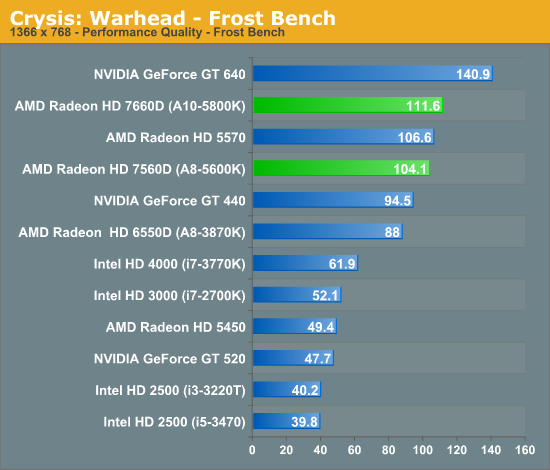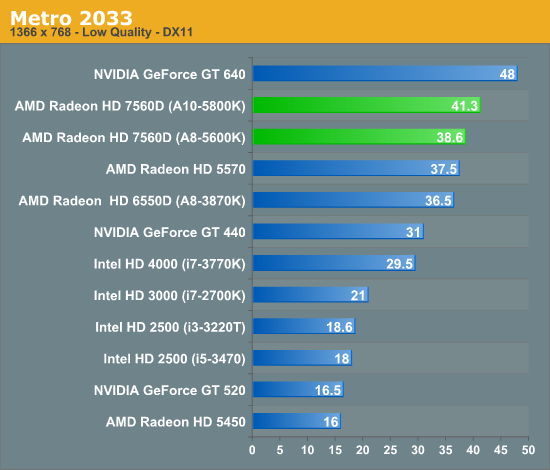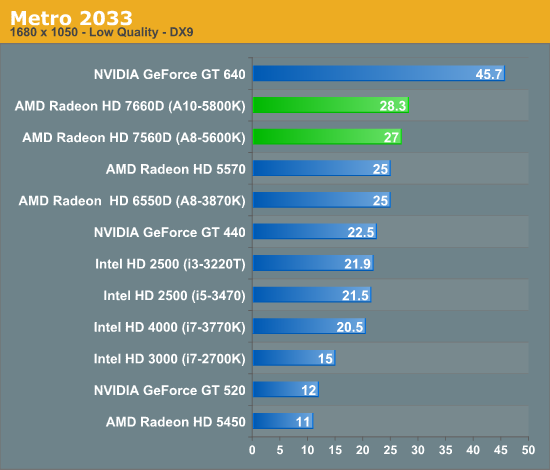AMD A10-5800K & A8-5600K Review: Trinity on the Desktop, Part 1
by Anand Lal Shimpi on September 27, 2012 12:00 AM ESTCrysis: Warhead
Our first graphics test is Crysis: Warhead, which in spite of its relatively high system requirements is the oldest game in our test suite. Crysis was the first game to really make use of DX10, and set a very high bar for modern games that still hasn't been completely cleared. And while its age means it's not heavily played these days, it's a great reference for how far GPU performance has come since 2008. For an iGPU to even run Crysis at a playable framerate is a significant accomplishment, and even more so if it can do so at better than performance (low) quality settings.



Crysis sets the tone for a lot of what we'll see in this performance review. The Radeon HD 7660D on AMD's A10-5800K boosts performance by around 15 - 26% over the top end Llano part. The smaller, Radeon HD 7560D GPU manages a small increase over the top-end Llano at worst, and at best pulls ahead by 18%.
Compared to Ivy Bridge, well, there's no comparison. Trinity is significantly faster than Intel's HD 4000, and compared to HD 2500 the advantage is tremendous.
Metro 2033
Our next graphics test is Metro 2033, another graphically challenging game. Like Crysis this is a game that is traditionally unplayable on many integrated GPUs, even in DX9 mode.



Metro 2033 shows us a 6 - 13% performance advantage for the top end Trinity part compared to Llano. The advantage over Intel's HD 4000 ranges from 20 - 40% depending on the resolution/quality settings. In general AMD is able to either deliver the same performance at much better quality or better performance at the same quality as Ivy Bridge.
The more important comparison is looking at the A8-5600K vs. Intel's HD 4000 and 2500. AMD is still able to hold onto a significant advantage there, even with its core-reduced GPU.










139 Comments
View All Comments
Voldenuit - Thursday, September 27, 2012 - link
Agreed. If anything, AMD's PR moves are a faux pas, because it leads the reader to wonder just how bad their x86 performance might be if they have to go behind readers' backs to manipulate public perception by forcing reviewers to cherry pick benchmarks.In reality, I expect Trinity's x86 performance to be acceptable, but AMD's tiered benchmark and preferential treatment of reviewers sets a bad precedent for the industry that Anand should not have agreed to.
Hubb1e - Thursday, September 27, 2012 - link
Think of this like the launch of the AMD 7660 D graphics card then have a cup of tea, and maybe you will feel better about it.I'm happy to have something to read about. They didn't have to release anything until Oct 2nd.
It sounds like a pretty decent GPU. It's something I can toss in the wife's computer and guests could have a pretty decent expeirence when they come over and I don't even have to worry about that extra idle power consumption of a graphics card that goes unused by my wife.
But, look at those die sizes. Anand compares them to the i5 since it shows them in a more favorable light. Drop the Ivy i3 in that chart at 116mm2 and Trinity looks like the fat girl at a wet T-shirt contest. She's got the biggest jugs but the sacrifice to get there may not be worth it.
CeriseCogburn - Thursday, October 11, 2012 - link
AMD is an evil, vile corporate pig filled with lies and spinmeisters toying with the pliable minds of the immensely ignorant fanbase of haters it has carefully developed over many years.Now it has turned fully to the darkside and launched an attack from it's crumbling deathstar, an attack never seen before. It's the head pig destroyer of review sites.
Be proud amd fans, all those years you fed on your hatred of nVidia and Intel, yesss... feel the hatred... let it flow through you...
You're no Luke Skywalkers, you have given in to the darkside....
Anand Lal Shimpi - Thursday, September 27, 2012 - link
It's a bolder move than manufacturers have tried in the past, but it's not unheard of. Most company sanctioned pre-release reviews have some sort of restriction put on them. No pricing discussion is not unusual, the GPU-focus here is unusual but not totally out of the ordinary. The original Intel sanctioned Conroe performance previews were done similarly (Intel set and controlled the only applications that could be tested).The original press embargo for Trinity was in October. If you wanted to show something earlier, these were the rules. I'm not a huge fan of staggered embargoes, but they exist and this wasn't the first one. Had AMD tried at all to influence the benchmarks we ran, tests we used or conclusions we came to I guarantee you that things would've unfolded very differently.
Take care,
Anand
juampavalverde - Thursday, September 27, 2012 - link
Its a known move from the manufacturers, and knowing what happens with the NDA's its hard, but also its the case of a product with a performance hard to measure at least in the individual metrics, because has everything onboard, so i have no chance of getting any conclusion just knowing half of the data, i dont know how much of the power comes from the IGP, or the CPU, or how powerul is the GPU in comparison with others in an apples to apples test (i dont know if every GPU was tested over the APU or in another test rig), and if the piledriver quad its holding back the whole APU or it is doing right. From the performance measured in the IGP, its just a meh comparing to Llano, and not far enough from the HD 4000.AMD its MAD if they want to play Intel games. Intel can do it because they control the market, but being the underdog, performing unspectacular and behaving mad and bad... oh dear... they will be bought by Qualcomm when their stock go further down.
Voldenuit - Thursday, September 27, 2012 - link
Anand, thank you for taking the time to respond with your thoughts.I do agree with you that this behaviour is not unprecedented in the industry, and all camps (red, blue, green) have done it at some point or another.
However, when Conroe previews were released, they were clearly marked as such.
The Trinity reviews out now might be more properly termed as previews, since the part is not available and will not be for a couple more weeks.
At the end of the day, the performance will be nothing unusual or unexpected, since we've had mobile trinity parts benchmarked for a while.
What worries me is that staged and staggered reviews under NDA and exclusivity clauses may become the norm if the rest of the industry picks up on this practice and runs with it.
I also don't think this PR stunt has worked in AMD's favor - rather than highlighting its (well-earned) GPU prowess, it's raising questions about its x86 performance (which are probably very close to the mobile part's documented performance) and the (probably unintended) ethics of attempting to influence the review process.
tecknurd - Thursday, September 27, 2012 - link
After reading that article at techreport.com, I can not believe that Anandtech have resorted to obey AMD's rules of reviewing the latest products. I was wondering where is the general usage benchmarks and where is the encoding benchmarks. I thought this is a review site and not some teaser. If I was a reviewer, I would post the benchmarks of general usage which means going against the email. A reporter has every right post the truth. Where is the truth on this site?Like I comment on other sites, AMD arrogance is ruin their reputation and the reputation of reviewers.
BTW, I doubt the email will hold up in court, so it is OK to disobey it unless the contract is ambiguous.
SleepyFE - Thursday, September 27, 2012 - link
OMG.Forget the e-mail, they signed an NDA!!
And there is truth in the article, just not the whole truth. You don't post everything that happens to you on facebook do you? Some thing are left out for whatever reason Consider the NDA as AMD's privacy settings.
Jamahl - Thursday, September 27, 2012 - link
Scott also "previewed" conroe under the kinds of limitations Anand spoke about.http://techreport.com/review/9538/intel-conroe-per...
The main difference is he didn't complain bitterly about it. Techreport doesn't have the staff to get these kinds of reviews done in time, so instead they take the easy option by slagging off AMD.
MrSpadge - Thursday, September 27, 2012 - link
It's not review of the product, but it's a review of the GPU performance. Period.